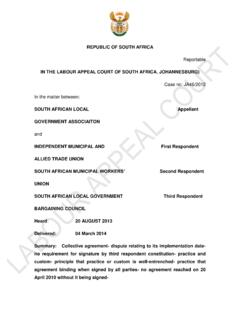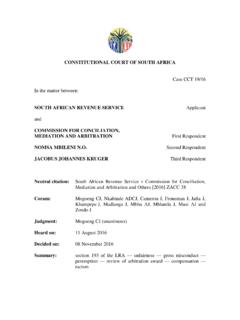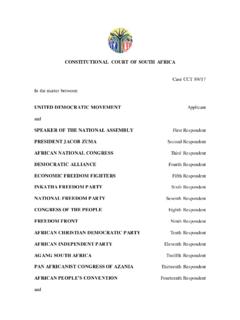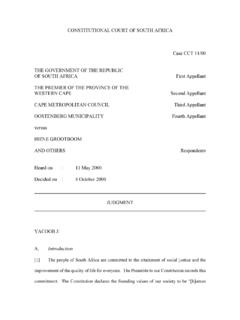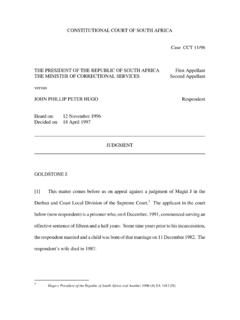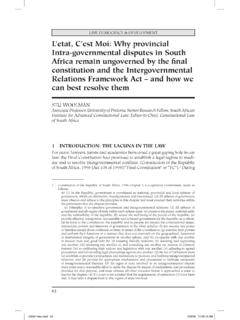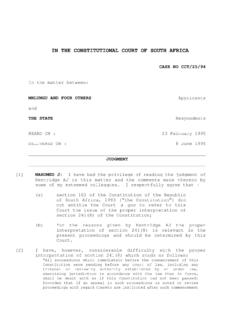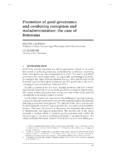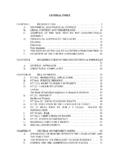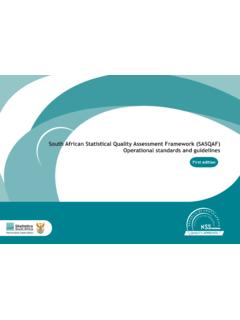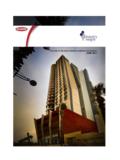Transcription of DECENT WORK: A SOUTH AFRICAN PERSPECTIVE
1 ISSN 1727-3781 ACHIEVING " DECENT work " IN SOUTH AFRICA? 2012 VOLUME 15 No 2 Author: T Cohen and L Moodley T COHEN AND L MOODLEY PER / PELJ 2012(15)2 320 / 569 ACHIEVING " DECENT work " IN SOUTH AFRICA? T Cohen L Moodley 1 Introduction The fundamental goal of the International Labour Organisation (ILO) is the achievement of " DECENT and productive work for both women and men in conditions of freedom, equity, security and human dignity".1 The concept of DECENT work "is based on the understanding that work is not only a source of income but more importantly a source of personal dignity, family stability, peace in community, and economic growth that expands opportunities for productive jobs and employment."2 In the furtherance of this goal the ILO's DECENT work Agenda3 aims to implement DECENT work at country level by means of policy and institutional intervention, and DECENT work Country Programmes have been developed, in coordination with ILO members, to identify DECENT work deficits in member countries and to devise targets and strategies to overcome such deficits.
2 In support of this the SOUTH AFRICAN government has pledged its commitment to the attainment of DECENT work and sustainable livelihoods for all workers and has undertaken to mainstream DECENT work imperatives into national development The four strategic objectives of DECENT work as identified by the ILO are: i) the promotion of standards and rights at work , to ensure that workers' constitutionally protected rights to dignity, equality and fair labour practices amongst others are safeguarded by appropriate legal frameworks; (ii) the promotion of employment creation and income opportunities, with the goal being "not just the creation of jobs, Tamara Cohen. BA LLB LLM PHD. Associate-Professor, Faculty of Law, University of KwaZulu-Natal, Luendree Moodley. LLB LLM Legal Advisor, University of KwaZulu-Natal, 1 ILO 1999 2 ILO 2010 3 ILO [Date unknown] 4 Zuma 2011 As early as in 2007 the ANC committed in the Polokwane Declaration to "making the creation of DECENT work opportunities the primary focus of economic policies".
3 T COHEN AND L MOODLEY PER / PELJ 2012(15)2 321 / 569 but the creation of jobs of acceptable quality";5 (iii) the provision and improvement of social protection and social security, which is regarded as fundamental to the alleviation of poverty, inequality and the burden of care responsibilities; and (iv) the promotion of social dialogue and tripartism. While the ideals of DECENT work extend well beyond the confines of the employment relationship, this article will be limited to an analysis of five statistical indicators, namely: (i) employment opportunities; (ii) adequate earnings and productive work ; (iii) stability and security of work ; (iv) social protection; and (v) social dialogue and workplace relations; to measure progress made towards the attainment of DECENT work objectives in SOUTH Africa. In so doing the obstacles to the attainment of DECENT work and the measures required to overcome such obstacles are identified.
4 2 The nature of the work force in SOUTH Africa The SOUTH AFRICAN work force is subject to both formal and informal employment relationships. According to the Quarterly Labour Survey for the 1st quarter of 20126 there are million people currently employed in SOUTH Africa, comprising million in the formal sector and million in the informal sector. In contradiction the Adcorp Employment Index (September 2011) reports that million people are currently employed in the formal sector in SOUTH Africa, which comprises of million workers engaged in typical employment and million in atypical employment. The report indicates that million people work in the informal sector, which it identified as the fastest-growing Informal employment, defined by Statistics SOUTH Africa as "employment in precarious work situations with no written contract and no benefits",8 includes the self-employed in informal enterprises, workers in unregistered enterprises and wage workers in informal jobs, many of 5 ILO 2010 5.
5 To attain this objective all forms of employment are to be accompanied by non-discriminatory treatment, safe working conditions, collective bargaining rights and social security. 6 Stats SA 2012 7 Adcorp 2011 The credibility of these statistics has been disputed by Stats SA. In turn the statistics generated by Stats SA have been criticised as failing to take into account the "unreported economy" (Sharp 2012 ). 8 Stats SA 2011 The QLFS is a household-based sample survey conducted by Statistics SOUTH Africa (Stats SA). It collects data on the labour market activities of individuals between 15 years and 64 years of age, who live in SOUTH Africa. T COHEN AND L MOODLEY PER / PELJ 2012(15)2 322 / 569 whom fall into what has been referred to as the "survivalist" category of Whichever are the more accurate statistics remains the subject of intense debate but it is indisputable that the high levels of unemployment, exacerbated by the global recession, have resulted in a disproportionate growth of the informal sector in SOUTH An increased reliance upon outsourcing and sub-contracting arrangements has given rise to the growing "casualisation"11 of the labour market and an unregulated and insecure labour force.
6 "Externalisation",12 in terms of which workers are supplied to a client by a third party by means of a commercial contract, has had a similarly detrimental impact on the labour market. The Adcorp Employment Index (September 2011) reports that 998 000 employees are currently employed by temporary employment agencies. In terms of this triangular employment relationship the recruitment, dismissal and employment functions normally performed by employers are outsourced to an intermediary, while the "task side" of the relationship is not In many instances the identity of the true employer is obscured and such employees are deprived of legal protection as a Gender inequalities continue to undermine DECENT work objectives, in spite of female labour force participation in SOUTH Africa having increased from 38% in 1995 to in Women employees face inequality and disadvantage in the 9 Theron 2008 ILJ 8.
7 10 Increasing informalisation has been attributed in part to the poor educational levels of work seekers, as those with little or no formal education are more likely to find work in poorly remunerated and unskilled informal employment (Bivens and Gammage 2005 ). In 2005 an estimated 16% of workers in the formal economy had completed less than a 6th grade education whilst 36% of the workers in the informal economy had less than a 6th grade education. of the informal economy workers had either a diploma or a higher degree. This was in contrast to the 22% of the formal economy workers who had an equivalent level of education. 11 Benjamin 2008 ILJ 1579 defines casualisation as the displacement of standard employment by temporary or part-time employment. 12 "Externalization" is described as the process of economic restructuring in terms of which employment is regulated by a commercial contract rather than by a contract of employment (Benjamin 2008 ILJ 1579).
8 13 Theron 2010 ILJ 845-846. 14 Theron 2010 ILJ 845-846. 15 Stats SA 2012 T COHEN AND L MOODLEY PER / PELJ 2012(15)2 323 / 569 workplace and face glaring pay differentials,16 gender stereotyping, discrimination based on maternity and family responsibilities and difficulties in balancing work and family life. Women are mainly concentrated in the feminised professions such as nursing and teaching (this is horizontal occupational segregation) while at the same time remaining in lower job categories than men (while this is vertical occupational segregation) and remain grossly underrepresented in senior positions. The 11th Annual Commission for Employment Equity Report (2010-2011)17 notes that women constituted a mere 19% of top management, with AFRICAN females constituting a paltry Of these, women held only of CEO/MD positions, of chairperson positions, and of In the 2010-2011 reporting cycle women constituted 29% of senior management, with AFRICAN females constituting Despite this, women constituted of professionally qualified employees and of skilled The report confirms that AFRICAN and Coloured females are disproportionally under-represented at all senior levels and are the least promoted.
9 Women employees remain over-represented in lower paid, less secure and unskilled positions, with 16% of women employees being employed in the informal sector, 21% in the elementary sector, and 15% in the domestic sector. The concentration of women in low-paid jobs, with limited access to job security and benefits, has contributed to the increasing "feminisation of poverty".20 An analysis of the employment-to-population ratio for persons aged 15-24 years (the "youth" population) between 2000 and 2009 reveals that the percentage of the youth population employed dropped from in 2000 to in 2008,21 with 71% of the unemployed being under the age of The Organisation for Economic 16 Women in paid employment in SOUTH Africa earn of men's remuneration (Commission for Gender Equality 2010 ). 17 Department of Labour 2011 18 Business Womens Association 2011 19 The report indicates that only 23% of promotions at top management level and of promotions at senior management were awarded to women employees.
10 While the public sector has had more success in addressing inequalities in senior positions than private sector employers, glaring inequalities nonetheless remain. 20 Department of Health 2008 21 Trading Economics 2011 22 The State of the Cities Report ( SOUTH AFRICAN Cities Network 2011 27) reveals that only one in eight youth of employable age in SOUTH Africa have a job. Ghai " DECENT work " 8 indicates that this trends is typical for most developing countries where high unemployment rates are often concentrated in urban areas and amongst youth. T COHEN AND L MOODLEY PER / PELJ 2012(15)2 324 / 569 Development (OECD) Economic Survey for SOUTH Africa 2010 23 confirmed that SOUTH Africa has "an extreme and persistent low employment problem which interacts with other economic and social problems such as inadequate education, poor health outcomes and crime" and recommended that youth-specific measures be made an integral part of the employment The Quarterly Labour Force Survey (1st quarter: 2012) places SOUTH Africa's unemployment rate at %, with total unemployment having increased from in the previous quarter.
